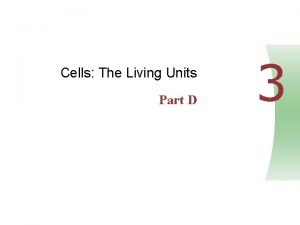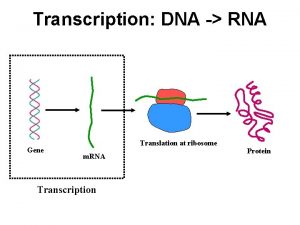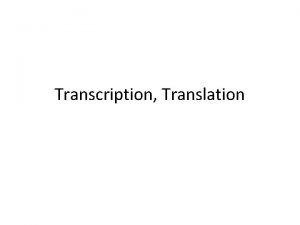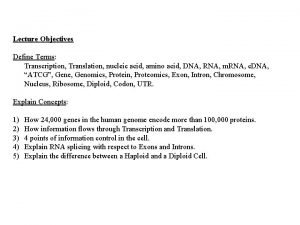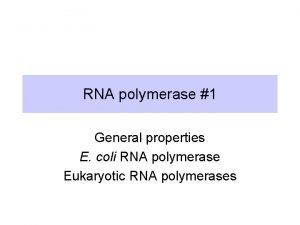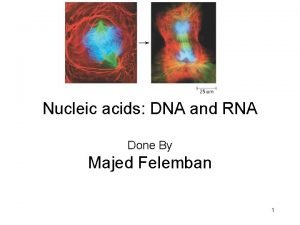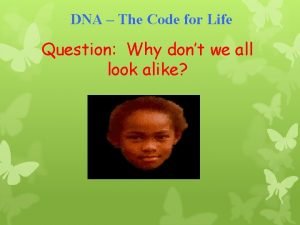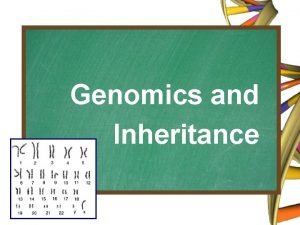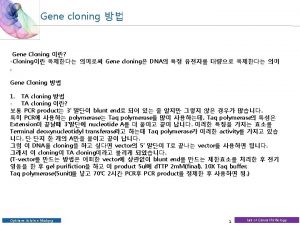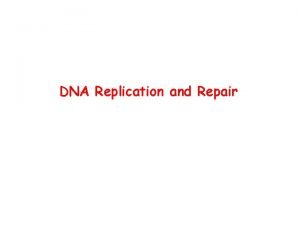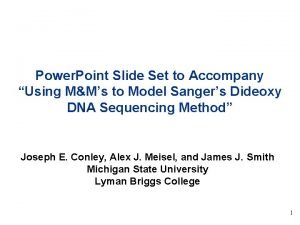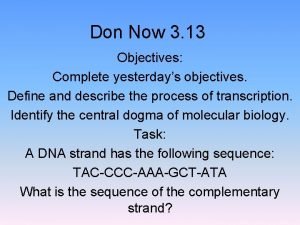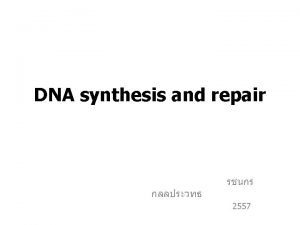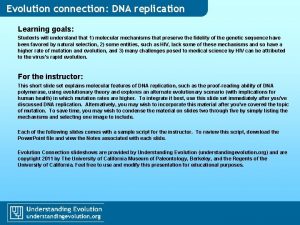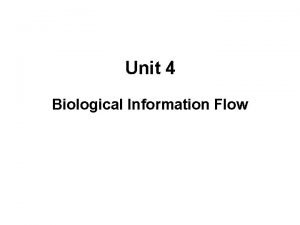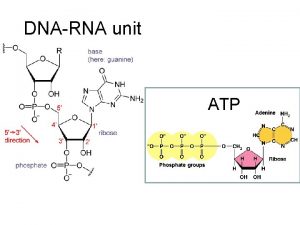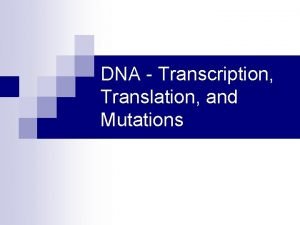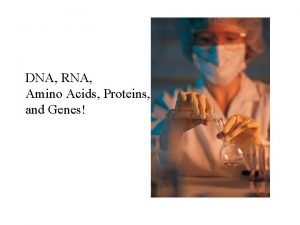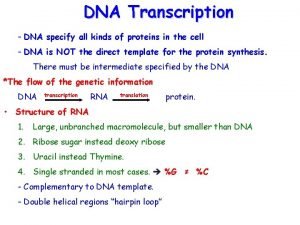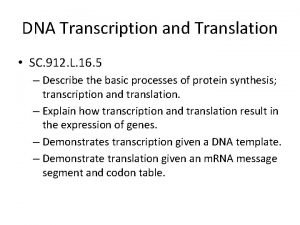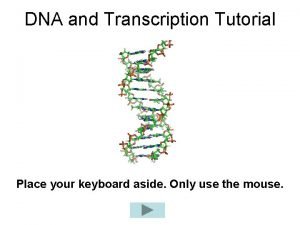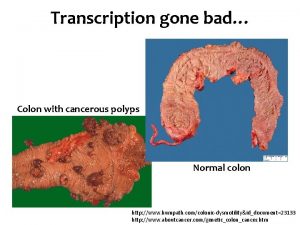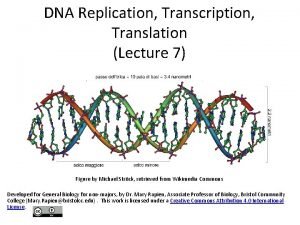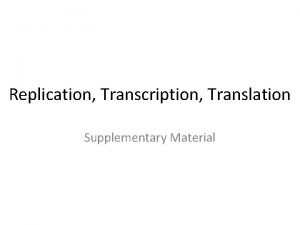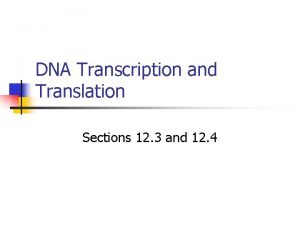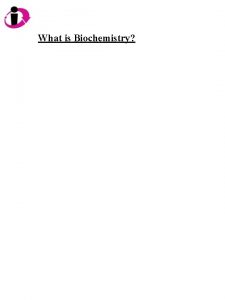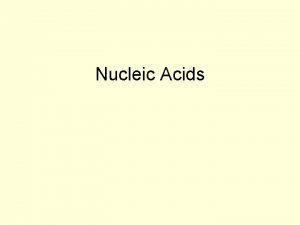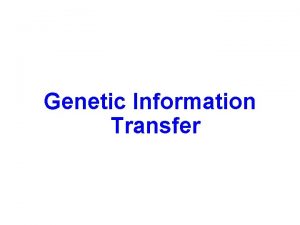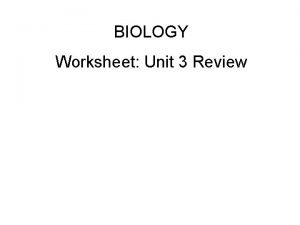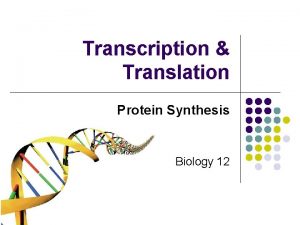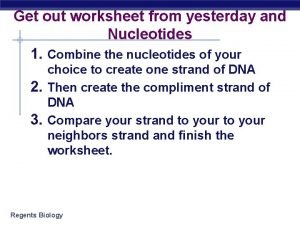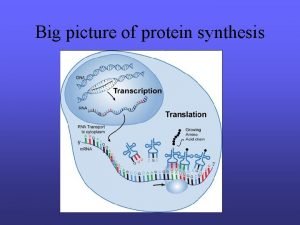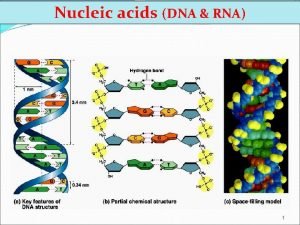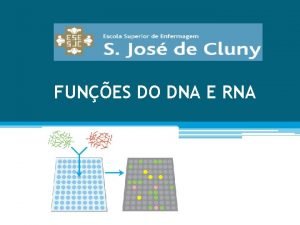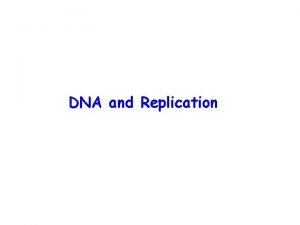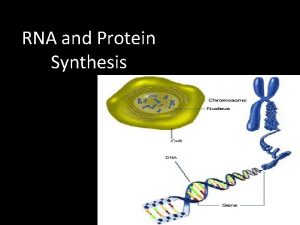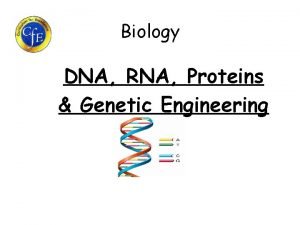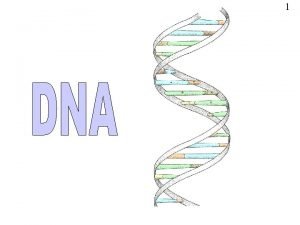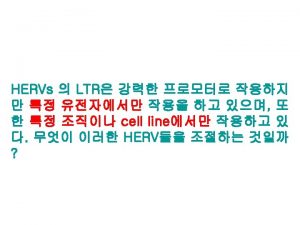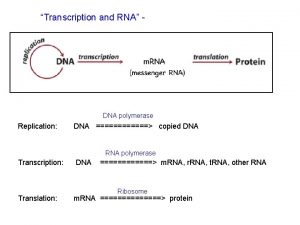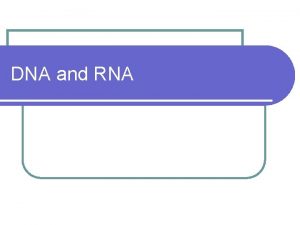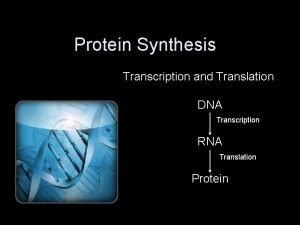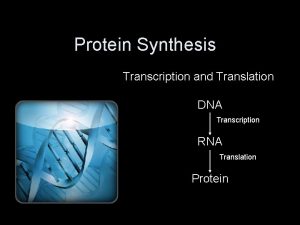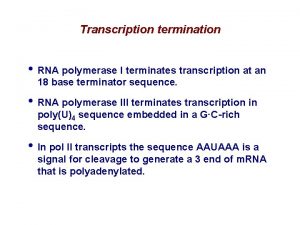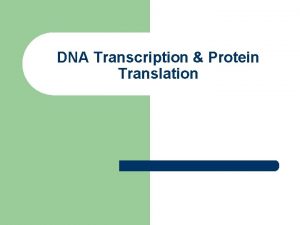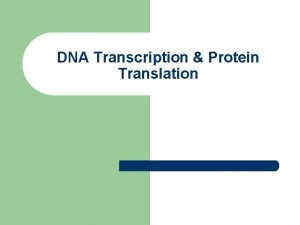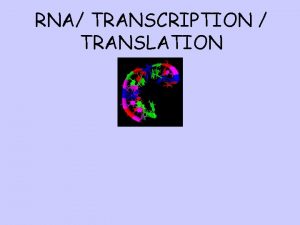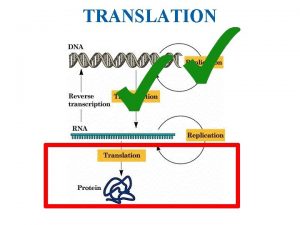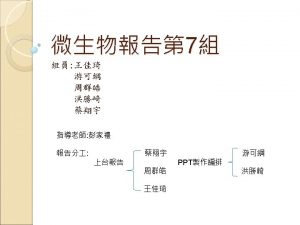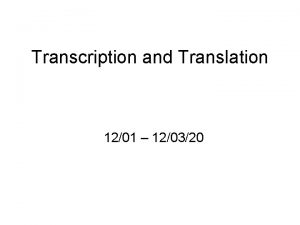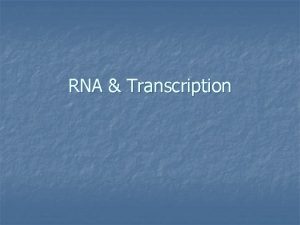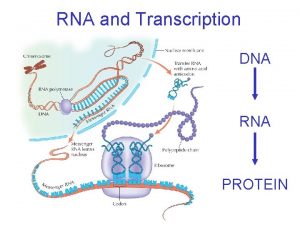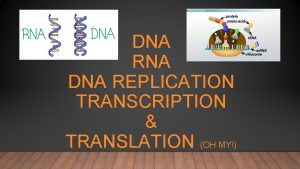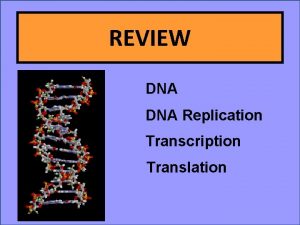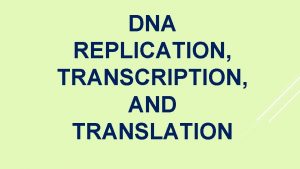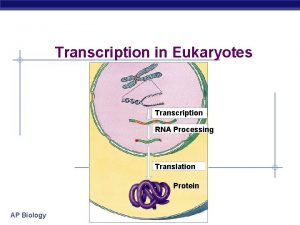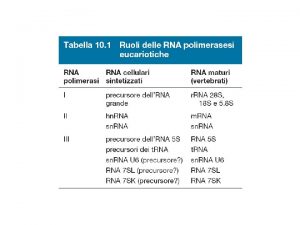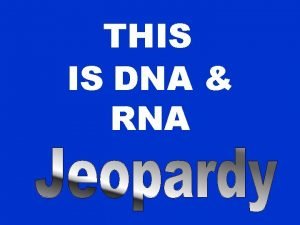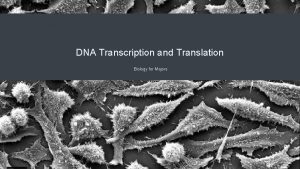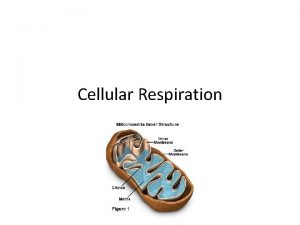Transcription Translation DNA RNA polymerase RNA nucleotides ATP


























































- Slides: 58

Transcription, Translation

• DNA + RNA polymerase + RNA nucleotides + ATP = m-RNA • Each messenger RNA (m-RNA) is a “cytoplasmic messenger” of a gene • The m-RNA attaches to a ribosome (“the construction sites” for proteins)

• How do we get the instructions which is in the nucleus to the construction site which is the ribosome?

• Chromosome 11 has the genes for insulin, hemoglobin

Making of RNA for transcription • Transcription: Transcription involves the assembly of a strand of RNA that is complementary to part of one of the DNA strands. The DNA double helix is relaxed during transcription.

Translation of the Genetic Code & Protein Synthesis • A. the nucleotide sequence of the m-RNA (corresponding to the nucleotide sequence of the DNA) specifies the sequence of amino acids in the protein • B. transfer RNA (“t-RNA”) act like “trucks” to transport the different types of amino acids to the ribosome construction site

• C. the amino acids are joined together by peptide bonds forming a polypeptide chain • D. the polypeptide chain coils-up into a portion

• A ribosome is made up of a type of RNA which is called ribosomal RNA • A ribosome looks like a clam shell

• Every three nucleotides is a codon or a triplet





The codons of m. RNA and the amino acids they specify • AUG = methionine and/or start



• How many types of amino acids are there? • Each “truck” or transfer RNA can only carry one type of amino acid so there as many transfer RNA’s as there amino acids

üDNA üRNA ütranscription ütranslation üAmino acid üProtein üCodon/ anticodon


Guiding question: How are proteins made according to the code in DNA?

cell chromosome nucleus DNA gene

Transcription

Transcription in a nutshell ü Occurs inside the nucleus ü Specific gene is copied into m. RNA ü One m. RNA codes a single protein ü End result is the code for a single protein RNA base parin g rules A pairs with U C pairs with G

Translation

Codon

m. RNA codon chart Alanine : Ala Arganine: Arg Asparagine: Asn Aspartic acid: Asp Cysteine: Cys Glutamic acid: Glutamine: Gln Glycine: Gly Histidine: Hist Isoleucine: Ile Leucine: Leu Lysine: Lys Methionine: Met Phenylalanine: Phe Proline: Pro Serine: Ser Threonine: Thr Tryptophan: Trp Tyrosine: Tyr Valine: Val START: Met

Translation in a nutshell ü Occurs in the cytoplasm ü Requires a ribosome ü Ribosomal complex: ribosome + m. RNA+ t. RNA ü m. RNA contains code for specific t. RNA ü Different t. RNA’s bring different amino acids to the ribosome g rules in r a p e s a b A N R ü End result is a protein A pairs with U C pairs with G


NUCLEUS CYTOPLASM (ribosome)

How do you go from DNA to the color of your eyes?

3 genes code for eye color Transcription and translation Enzyme (protein) That controls levels of melanin

Summarizing I used to think … but now I know: ü Each one will answer: I used to think the color of the eyes came from……. . But now I know…….


• Where are proteins that are made by ribosomes stored?

Answer • Sacs of the Golgi complex

• RBC = hemoglobin • WBC = antibodies • Pancreatic cells = insulin, glucagon

• The DNA sequence determines the RNA sequence which determines the protein sequence

• If there is a defect in the DNA sequence it would result to a defect of the RNA sequence resulting to a defect of the protein created

What are three types of RNA?

In the nucleus: • DNA provides the template for its own replication and for the production of three kinds of RNA

• m. RNA – carries the genetic code for the translation of genetic information into proteins • r. RNA – becomes a constituent of ribosomes • t. RNA – links the amino acids that it carries to m. RNA

• In the ribosomes, m. RNA provides the template upon which amino acids are assembled into proteins

• Transcription – making a copy of a gene • Each codon specifies a specific amino acid

Catabolism of Proteins • NH 2 Amino Acids Ketoacids urea (excreted in urine)

Synthesis of Nucleic Acids • A. DNA Replication – before cell division (mitosis) • B. Transcription (RNA) – before a cell can synthesize a protein • Question: What is in our food?

Catabolism of “Old Nucleic Acids” • Nucleic Acids Nucleotides uric acid • Uric acid (excreted in urine) • Question: What is gout? • Cata – means to break down like the word catastrophic

• 2 major products that we produced are urea and uric acid • Breaking down of amino acids = urea • Breaking down of nucleotides = becomes nucleotides = then becomes uric acid

• Uric acid – carried in our bloodstream then excreted to urine

• Blood Chemistry – urea nitrogen, creatinine, uric acid • These are three major waste products • Urea nitrogen and uric acid – formed from the breakdown of protein

• Creatinine – waste product from muscle tissue • - the normal values are different for men and women

• Everything that we eat comes from living organisms so we are eating cells

Synthesis of Nucleic Acids • A. DNA Replication – in order for cells to divide • B. Transcription – makes RNA in order to make proteins

3 types of arthritis • 1. osteoarthritis – trauma – repeated injuries • 2. rheumatoid arthritis – auto-immune disease – more common in women • 3. gouty arthritis – gout – a metabolic disorder • * metabolic – a biochemical disorder

• Eating skeletal muscle can exacerbate gouty arthritis. • Why? • What is skeletal muscle made of?

• Athletes are prone to osteoarthritis • • There are different medications for the different types of arthritis

• Gout = hyperuricemia • Hyperuricemia – high levels of uric acid in the blood • These high levels of uric acid accumulates in the large toe • *crystallized uric acid

• If somebody has gout they must not eat lots of red meat. • Why?

 Replication fork
Replication fork What role does dna polymerase play in copying dna?
What role does dna polymerase play in copying dna? Dna to rna transcription
Dna to rna transcription Ribosomem
Ribosomem Venn diagram dna and rna
Venn diagram dna and rna Transcription end result
Transcription end result Dna transcription and translation
Dna transcription and translation Dna replication transcription and translation
Dna replication transcription and translation Amino acid nucleotide
Amino acid nucleotide Dna rna protein synthesis homework #2 dna replication
Dna rna protein synthesis homework #2 dna replication Transcription initiation in eukaryotes
Transcription initiation in eukaryotes Rna polymerase
Rna polymerase Rna polymerase 1 2 3
Rna polymerase 1 2 3 Four nucleotides of dna
Four nucleotides of dna When dna untwists, unzips, and nucleotides fill in.
When dna untwists, unzips, and nucleotides fill in. Order of nucleotides in dna
Order of nucleotides in dna Types of dna polymerase in eukaryotes
Types of dna polymerase in eukaryotes Taq polymerase
Taq polymerase Lagging strand
Lagging strand Types of dna polymerase in eukaryotes
Types of dna polymerase in eukaryotes Dna polymerase
Dna polymerase Dna polymerase iii
Dna polymerase iii Dna polymerase
Dna polymerase Template strand, new strand, base pair, and dna polymerase.
Template strand, new strand, base pair, and dna polymerase. Helicaee
Helicaee Dna polymerase
Dna polymerase Rna transcription
Rna transcription Rna atp
Rna atp Translation
Translation Dna transcription
Dna transcription Dna transcription
Dna transcription Dna transcription
Dna transcription Dna and transcription tutorial
Dna and transcription tutorial Translation transcription
Translation transcription Perbedaan replikasi virus dna dan rna
Perbedaan replikasi virus dna dan rna Transcription and translation
Transcription and translation What provides instructions for protein synthesis
What provides instructions for protein synthesis Dna meaning
Dna meaning Translation protein synthesis
Translation protein synthesis Transcription translation replication
Transcription translation replication Messenger rna sequence
Messenger rna sequence Translation transcription
Translation transcription Biology transcription and translation
Biology transcription and translation Central dogma
Central dogma Blood type chart
Blood type chart Transcription or translation
Transcription or translation Transcription and translation practice worksheet answer key
Transcription and translation practice worksheet answer key Picture of protein synthesis
Picture of protein synthesis Protein synthesis gcse
Protein synthesis gcse Nucleic acid dna structure
Nucleic acid dna structure Dna and rna
Dna and rna Dna e rna
Dna e rna Minor groove
Minor groove Cytoplasm structure
Cytoplasm structure Dna and rna similarities
Dna and rna similarities Dna and rna
Dna and rna Fraction
Fraction What is code 1
What is code 1 Somatic vs germ cells
Somatic vs germ cells


